I have driven many hire cars around more hairpin bends than I could ever count in a lot of scenic southern European uplands in the last five years, but this is right up there with the most spectacular regions of them all. Les Cévennes lies around 200 miles from Provence at the south-eastern edge of France’s Massif Central. This is a huge and largely unspoilt landscape of high granite peaks, limestone plateaux dissected by dramatic gorges, towering inland cliffs and endless forests (pictured below).
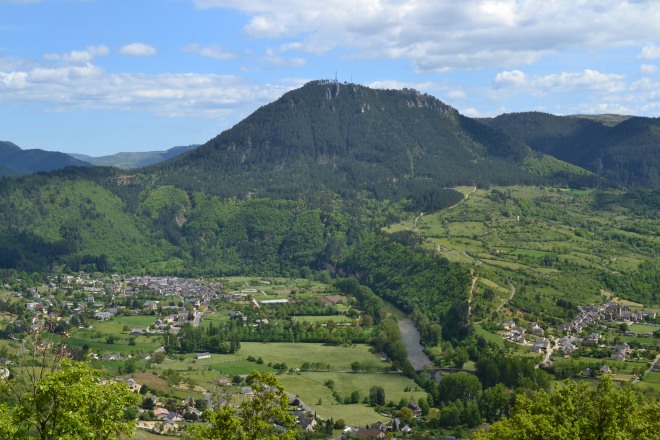 So where does a lone lepidopterist begin to look for butterflies in all this vastness? As a week earlier in Provence I arrived here unresearched with a “go out and see” attitude to things. But if Le Luberon dwarfed Les Alpilles then this place is, well massif as they say here. On Sunday I drove out from my base at Marvejols with a vague idea of exploring the Gorges du Tarn route. This follows the D90 road roughly south-west of Florac, the administrative centre of the park.
So where does a lone lepidopterist begin to look for butterflies in all this vastness? As a week earlier in Provence I arrived here unresearched with a “go out and see” attitude to things. But if Le Luberon dwarfed Les Alpilles then this place is, well massif as they say here. On Sunday I drove out from my base at Marvejols with a vague idea of exploring the Gorges du Tarn route. This follows the D90 road roughly south-west of Florac, the administrative centre of the park.
But winding roads in scenic uplands inevitably means bikers. There are hundreds of them here. Well each to their own, so at a village Molines I turned off the D90 and headed north along the D31 back towards Marvejols to seek peace and solitude. The road climbs one side of a sunny, sheltered valley that looked good butterfly country, so I turned off to the right then walked back down a rough path (pictured below) through stony, wild flower-rich habitat.
The first butterflies to appear were inevitably Wall Brown, seemingly a default species in this part of France. The first encounter of note was with a cluster of Marsh Fritillary, that were soon followed by two more of that family. Weaver’s Fritillary (pictured left below), a lifer is fairly widespread throughout southern France. To me the clearest diagnostic is the occasional larger dots in the row just above the base of the hind wings. One Glanville Fritillary (right below) was also recorded here.

Weaver’s Fritillary (male)

Glanville Fritillary
Thereafter the roll call just kept on growing. Skippers – Dingy, Grizzled and what I took to be Red Underwing – were competing for territory with Common and Small Blues and Brown Argus. Scarce Swallowtail, regular and Pale Clouded Yellow (lifer) would waft past at intervals. Small Heath, Small Copper, Orange Tip, Small and Wood White, Brimstone and Osiris Blue (lifer) made up a total of 19 species at this first, randomly discovered site.

Escher’s Blue

Escher’s Blue
I followed the path downhill almost as far as the village. Then on the way back up again the site’s 20th and stand-out butterfly, a fourth lifer made itself known. Escher’s Blue in appearance (pictured above) lies somewhere between Adonis and Common Blue, being not quite as bright as the former but with a more iridescent purple tint than the latter. Quite a large blue, it is widespread in the Mediterranean region from eastern Spain to Greece, flying in flowery, rocky places such as this from May through to August.
On my uphill walk many more Marsh Fritillary had become active. These are very photogenic butterflies in my experience and I usually capture interesting pictures of them. The following will add some different back-drops to my collection.

Marsh Fritillary
I remained here until 2pm then went on to look for further good sites in different habitats, but without success. It had been an excellent start but over the next two days things were much more difficult. I know of no on-line resources for locating butterflies in France, and have found just one published trip report from Limosa Holidays in 2011. Butterflies seemed to be a lower priority than botany and birds for that particular group and they had lousy weather, but the report did suggest more sites in the north-east Cevennes that I investigated on Monday.
Immediately east of Florac and north of the D998 road to Le Pont-de-Montvert is a hilly area called les Bondons. There along a very minor road to a village Chadenet was a sunny corner that produced two more new butterflies. The first of these was a Sooty Copper (pictured below) that I watched for some time returning to the same spot as they are said to do. This one displayed a more purple tone than Collins’ illustration and photographs on the web site butterfliesoffrance.com show. I suppose that like a Purple Emperor in miniature this depends on how light catches the insect.

Sooty Copper (male)

Sooty Copper (male)
The second lifer here was an as attractive Chequered Blue that looks like a bigger version of Baton Blue on the top-side but has very bright and distinctive underwing markings. It is quite a localised and sporadic species in southern Europe, that in France occurs in south-eastern areas. This little beauty too kept returning to the same place on a wood pile but without ever settling in a position to photograph well.

Chequered Blue

Chequered Blue
Out of Les Bondons flows the River Briançon. From a bridge on the D135 road at N44°22.072′ E3° 37.124′ an often overgrown track runs north to a village Lozerette. Along here one or two big butterflies crossed my path without stopping, then I spotted a very big butterfly indeed. This was a Camberwell Beauty, the first I have ever seen. But it was being harassed by a small Fritillary every time it tried to settle, before gliding majestically and disdainfully away and up into the trees. Nothing else settled here either and I didn’t get any pictures at this site. There were more Chequered Blue here too and a lot of Wood White.
From here I drove on to Le Pont-de-Montvert then north over Mont Lozère, the highest ground in this part of les Cévennes; but without finding more productive sites. On Tuesday morning I started at the granite peak of Lozère, around which lies wet heather moorland. This is said to be good habitat for several species I have yet to see, but at three stops in sample habitat I found only Green Hairstreak. The feeling was growing in me, having begun a day earlier that perhaps I have timed this visit too early for many butterflies read about.
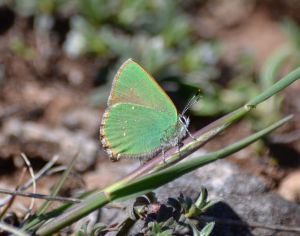
Green Hairstreak
Naturetrek comes here in mid-June, and I next checked out a locality on their agenda. This is a ridge to the south-east of Florac called Corniche des Cévennes, along the top of which a road runs to the town of Le Pompidou. Here there were wonderful wildflower meadows with myriad Orchids and Pasque Flowers but very few butterflies save for Green Hairstreak again. I suppose this sort of habitat is more associated with high summer than May species but it was still disappointing not to see more.
My sense of discomfort was now growing into the fear that I had made a serious error of judgement in coming to les Cévennes. I needed very much to see and photograph some butterflies, and so set the satnav for that superb spot from day one. So why is this location at N44° 23.237′ E3° 31.378′ so butterfly friendly whilst almost everywhere else has been disappointing? Well it’s rocky, flowery habitat in a sunny but sheltered open valley and I just haven’t come across more places like it. Steep, forested and fenced off is more usual here.

Escher’s Blue (mating pair)

Wood White
Most of the same butterflies were active again, so what was happening second time around? The Marsh Frits were sitting up to be noticed as ever but I had done them justice three days earlier. Mr and Mrs Escher were getting it on in the late afternoon sunshine (pictured above left), while the tinies continued to battle for bragging rights all around them. There seemed to be more Escher’s Blue here today as if they are still emerging, as they should be at this time.
But the butterfly I most wanted to photograph was Pale Clouded Yellow and one duly obliged (pictured below, left). Further down the track I came across what I identified as two of the brighter, lemon yellow Berger’s Clouded Yellow, one of which went into the can too (below, right). These are the ones that always flew past and kept on going in Provence. I hope I have identified the two smaller CY species correctly, but if not am open to expert guidance. With these results my spirits were restored.

Clouded Yellow sp

Berger’s Clouded Yellow
Over the next three days I continued to look for butterflies in different habitats at randomly selected sites, with varying degrees of success. On Wednesday in one of the limestone plateaux of the western Cevennes, le Causse Mejean I followed a good looking track that climbed a wooded valley from N44° 13.401′ E3° 17.631′. Here in overcast conditions I noticed Small Blue-sized butterflies with violet blue top sides going past me. These had to be Osiris Blue that occurs in low density in southern France but whose range extends from Spain to Central Asia. When settled in the cool temperature they were very approachable and so the ID was clinched.
On reviewing my pictures and checking them against butterfliesoffrance.com I realised I had also seen this species on day one at the site by the D31 road north of Molines. By comparison with Small Blue the male Osiris has sharply defined black marginal borders, and both genders have a noticeably different underwing pattern to Small Blue. In the following collage I have included a Small Blue top side image from this trip and an underside picture from my archive.

Osiris Blue (male)

Osiris Blue

Osiris Blue (fem)

Small Blue

Small Blue
This site also produced two Fritillary additions to my life list, but I didn’t realise what they were until reviewing my photographs back at home. I had rather hoped that some finds might turn up at this later stage. The left hand butterfly (below) is, I believe a female Weaver’s Fritillary that I confused with Small Pearl-bordered until matching my picture to those on butterfliesoffrance.com. In the same way I had initially thought the male Weaver’s recorded on day one was Pearl-bordered, unlikely as that other setting had seemed. The right hand item (below) is a rather worn Queen of Spain Fritillary.

Weaver’s Fritillary (fem)

Queen of Spain Fritillary
Thursday morning was lost to the only heavy rain of this week. The afternoon was spent exploring some southern areas of Les Cévennes, drawing blank for butterflies time and again. A very cold wind was blowing now, and chatting to a staff member at the Mont l’Aigoual tourist office I learned it had been an unusually cold spring in the region this year. So here was a possible explanation why so few butterfly species were on the wing in many places searched.
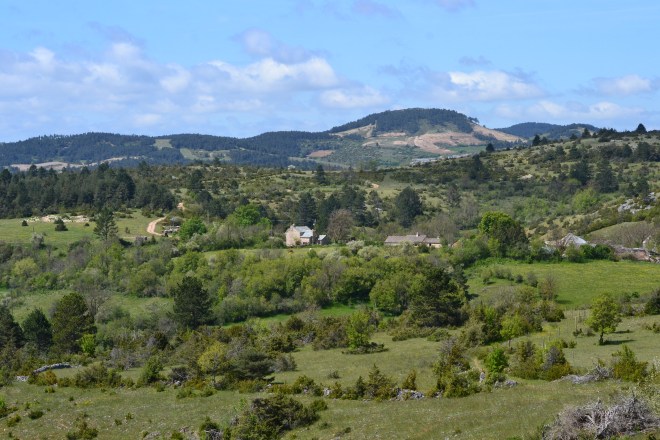
Limestone country of Les Causses
On my final day I didn’t wish to travel too far from base and so explored another north-eastern limestone plateau, Le Causse de Sauveterre. Along a minor road south-west of a village Champerboux I located a promising looking area (pictured above) and walked from N44° 23.838′ E3° 23.527 along a rising track through rocky, grassy land with a rich limestone flora. The profusion of Pasque flowers in particular here was astonishing.
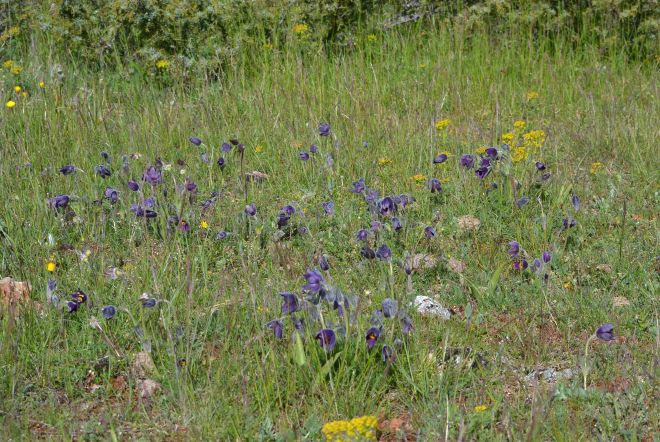
Pasque flower plot
It was a gloriously sunny day to end the trip. Amongst all this warmth and colour were varying quantities of smaller grassland butterflies seen each May in England: Green Hairstreak, Dingy and Grizzled Skipper, Small Heath, Orange Tip, Brown Argus, Common and Small Blue. Remarkably to me there were even Wood White here, a species that I associate with woodland at home but have encountered in much more open habitats here. Some Baton Blue (pictured below) were also on the wing.
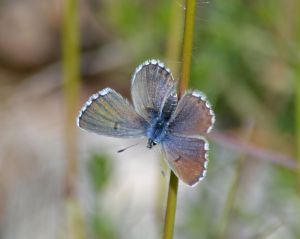
Baton Blue
In place of Adonis Blue there was another less bright butterfly of similar size and jizz. This lacked both the purplish iridescence of the Escher’s seen earlier in the week, and the diagnostic black lines through the white marginal borders of Adonis, though the black of the border extended inwards along the veins . There were plenty of them here that I identified as Turquoise Blue (pictured below top). This grassland species of upland slopes ranges across southern and eastern Europe as far as the Caucasus. It was my fifth new blue of the trip and the stand out butterfly of the final day. The following grid includes male Adonis Blue (middle row) from Provence and Escher’s Blue (bottom row) from this trip for comparison.

Turquoise Blue

Turquoise Blue

Adonis Blue

Adonis Blue

Escher’s Blue

Escher’s Blue
No Cévennes trip report would be complete without some orchids. The national park is renowned for them and there were plenty in the wild flower meadows of this Causse de Sauveterre landscape. Here (pictured below) are some that caught my eye especially, though I do not know their names.

Lady x Monkey Orchid

Lady x Monkey Orchid

Lady x Monkey Orchid

Early Purple Orchid

Lady x Monkey Orchid

Burnt Orchid
Eventually I left this scenic and uplifting location to see if anything new was flying at the productive site of day one. There were now more Escher’s and Osiris Blue here than previously, and in two spots I found congregations of different blues (below left) possibly extracting moisture or salt from the soil. Amongst these was another lifer Green-underside Blue, a fairly common and widespread species of diverse habitat that flies across much of continental Europe from late April to early July. The top butterfly in the right hand picture is one.

Green-underside (at top) and other Blues
So my first serious excursion into butterflying France was over. Despite appearances the fortnight in Provence then Les Cévennes was by any standards a half-baked experience. I was disappointed to gain only 11 life list additions in a country with so many species to offer, and the trip just involved too much searching and not enough finding. I left with the impression that an imminent explosion of lepidopteron life and colour awaited anyone who might time their 2016 Cévennes visit a little later than I did. But this was intended as a fact finding exercise and I expect I’ll return at some future time, probably in June and definitely better researched.
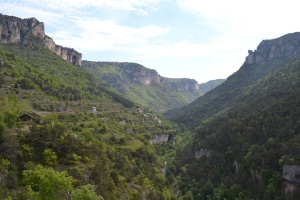
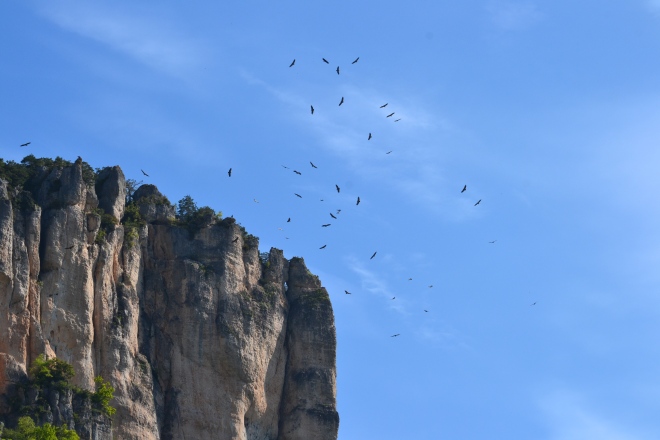
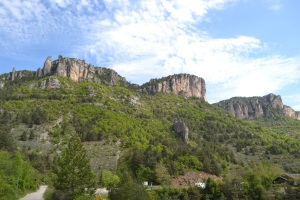

 So where does a lone lepidopterist begin to look for butterflies in all this vastness? As a week earlier in Provence I arrived here unresearched with a “go out and see” attitude to things. But if Le Luberon dwarfed Les Alpilles then this place is, well massif as they say here. On Sunday I drove out from my base at Marvejols with a vague idea of exploring the Gorges du Tarn route. This follows the D90 road roughly south-west of Florac, the administrative centre of the park.
So where does a lone lepidopterist begin to look for butterflies in all this vastness? As a week earlier in Provence I arrived here unresearched with a “go out and see” attitude to things. But if Le Luberon dwarfed Les Alpilles then this place is, well massif as they say here. On Sunday I drove out from my base at Marvejols with a vague idea of exploring the Gorges du Tarn route. This follows the D90 road roughly south-west of Florac, the administrative centre of the park.









































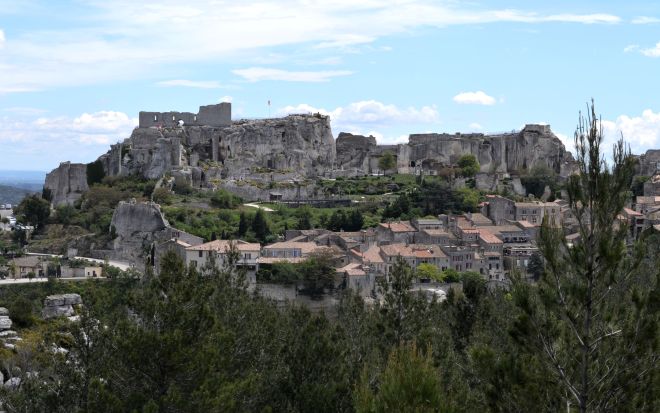


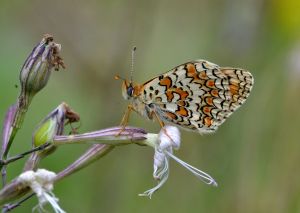







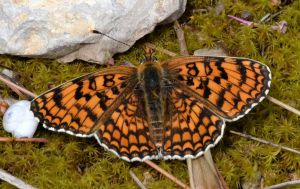


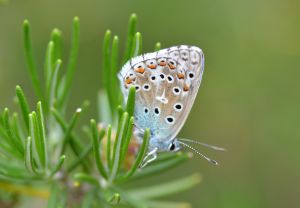
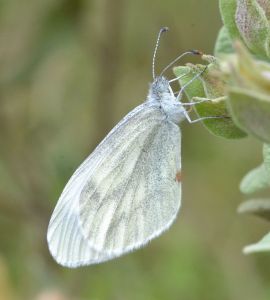








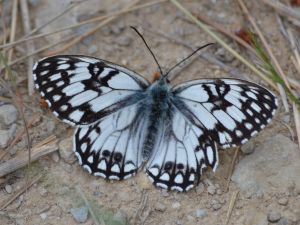
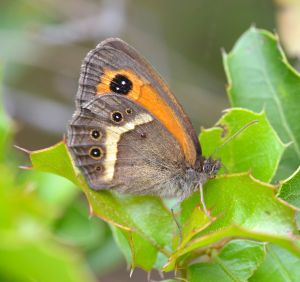
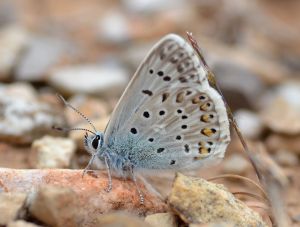
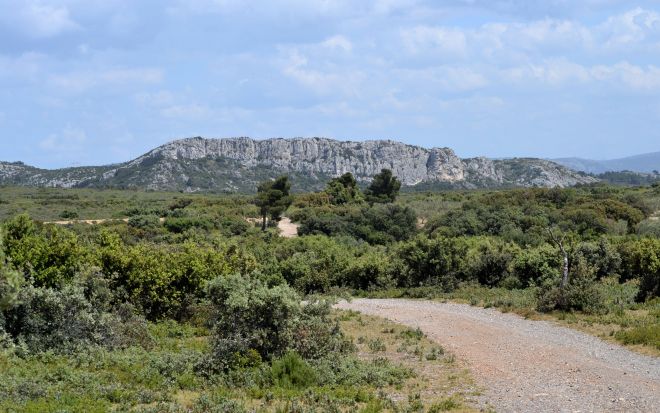 I made an afternoon revisit to one location (pictured above) two days later in bright sunlight, to see what else could be found in more butterfly friendly conditions. This is a flat area of scrub land north of the D17 road between Eyguieres and Aureille. If anything there seemed to be less on the wing than on day one. I recalled how in Portugal the Gatekeepers in particular liked to keep in shady cover in hot weather. Everything was now that much flightier and the wind made photographing perched subjects difficult.
I made an afternoon revisit to one location (pictured above) two days later in bright sunlight, to see what else could be found in more butterfly friendly conditions. This is a flat area of scrub land north of the D17 road between Eyguieres and Aureille. If anything there seemed to be less on the wing than on day one. I recalled how in Portugal the Gatekeepers in particular liked to keep in shady cover in hot weather. Everything was now that much flightier and the wind made photographing perched subjects difficult.
